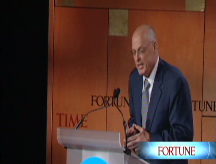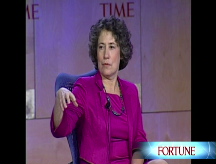No blank check for Paulson
Now that he's spent nearly all of the bailout's first $350 billion, here's what Congress should demand before releasing the remaining money.

NEW YORK (CNNMoney.com) -- Whether you love or hate the idea of Washington loaning the Big Three money, the government has learned its lessons from the mistakes of the bank rescue plan and has crafted a better bailout for the automakers.
Both Congress and the White House want to ensure that the $15 billion they plan to lend Detroit is handled in a more efficient and effective manner than the $335 billion that the Treasury Department has already parceled out as part of the $700 billion bank bailout.
Now that all but $15 billion of the first half of the bank bailout has been spoken for, either outgoing Treasury Secretary Henry Paulson or his designated successor, Timothy Geithner, will soon have to ask Congress for approval to tap the other $350 billion for the Troubled Asset Relief Program, or TARP.
So what should lawmakers do once the request is made? They should only say yes if Treasury agrees to numerous conditions.
First, Treasury has to prove to Congress that a decent portion of the remaining $350 billion will not be used just for making investments in banks.
The bailout was initially pitched as a way for the government to help banks by buying up their soured mortgage assets.
Instead, Paulson turned around a few weeks after the bill was passed and decided it would be better to inject capital directly into banks by having the government take equity stakes in them.
To be sure, Paulson may have had a legitimate reason to shift gears. Haag Sherman, managing director with Salient Partners, an investment firm based in Houston with about $9 billion in assets, said that $700 billion was "nowhere close to what was needed" to truly tackle the issue of bad loans on banks' books.
That said, Paulson's failure to realize this before making his first plea to Congress created a PR nightmare that made the bailout look like a gift to those who screwed up. So Treasury now must admit that other regulators, most notably FDIC Chariman Sheila Bair, also have good plans for how to use the TARP money, ideas that will help consumers more directly.
Bair has been a vocal supporter of using TARP funds to aid borrowers struggling to pay their mortgages. Sherman said Paulson would be wise to listen to her.
"Some portion of the remaining $350 billion should be used to modify mortgages. Bair has a sensible plan," Sherman said. "The housing market has to stabilize."
And it does look like Congress will demand that stemming the rising tide of foreclosures be a central part of how the rest of the TARP money is spent.
Jaret Seiberg, an analyst who follows financial policy for Stanford Group, attended an Office of Thrift Supervision housing forum Monday. He noted in a report Tuesday that House Financial Services Committee Chairman Barney Frank, D-Mass., made it clear at this forum that Treasury had to spend on mortgage modification programs.
"Rep. Frank said Treasury sold Congress on TARP being used for foreclosure mitigation. Until Treasury uses TARP for foreclosure mitigation, Congress is likely to block the release of the final $350 billion," Seiberg wrote.
While Paulson has taken flack for changing the focus of TARP, it's not completely fair to say that investments in banks have been a flop because they haven't panned out yet.
It's overly simplistic to say that Treasury is giving $700 billion of hard-earned taxpayer money to fat cats on Wall Street. That's a populist argument that misses the point. This is an investment. And if it works, the government and, by extension, you and I, benefit.
"I suspect in three to four years, Treasury will make money on the shares they bought, but until they have proof that they bought wisely there is going to be skepticism," said Craig Callahan, president and co-founder of ICON Advisers, a Greenwood Village, Colo.-based money management firm with about $4 billion in assets.
That said, it's fair to wonder if Treasury is making investments in the right banks. Some banks should be allowed to fail. Not all of them deserve a lifeline.
"What Congress and regulators have to make sure is that the money is not going to companies that are not likely to survive. There needs to be continued scrutiny so that dollars are not wasted," said Frank Barkocy, director of research with Mendon Capital Advisors, a firm that invests primarily in financial stocks.
"In several instances, some banks have gotten money where I was surprised to see that funds were going to them." Barkocy added.
Finally, the biggest complaint that many have about the bailout is that many banks appear to be either sitting on the cash they are getting or using it for other purposes, such as acquiring weaker rivals.
For example, it certainly didn't pass the smell test, so to speak, to see PNC (PNC, Fortune 500) announce on the same day that it was receiving $7.7 billion in TARP money that it was also buying struggling National City for $5.6 billion.
Of course, Congress and Treasury shouldn't mandate exactly what each penny must be used for.
But there has to be a better solution than the current practice of giving money to banks with the hope that they will lend it. Treasury has to make sure banks aren't just using the money to make earnings look better or to build war chests.
"There has to be direction given to the use of these funds," Barkocy said. "I'm not sure if banks are holding back because of the nature of the economy, but the government may have to suggest that some of the funds be going back out to borrowers."
At the end of the day, even though banks got into this mess because of too many exotic loans to too many borrowers with poor credit histories, the solution to the credit crunch is not a complete clamping down on lending.
One corporate lawyer who works with the banking industry and is a former government official said that regulators may have to go as far as to threaten to take back money it is investing if banks aren't using it properly.
"You're going to need to see some form of carrots and sticks. Use it or lose it," the lawyer said. "Banks can't sit on the sidelines. You have to handicap risks, but you have to take some too." ![]()




